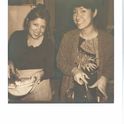What is the difference between Russian and thousand island dressing ?
5 Comments
Bill C.June 11, 2016
I have old cookbooks from the early 1900's. It seems they couldn't decide the difference back in that age. The variations and ratio of ingredients overlap. Some Russians even have egg, while some Thousand Island dressings don't. It really seems that there has never been a real consensus and never will. There is no one answer for what makes a Russian dressing a Russian dressing. And there is no one answer on what a Thousand Island Dressing is.
Kristy M.March 16, 2012
NeuB, while we appreciate your enthusiasm and participation on the hotline, your tone is inappropriate. There is no need to attack other community members for having different opinions, experiences, or research you don't agree with.
amysarahMarch 16, 2012
Not to get into the middle of this serious debate, but I think the confusion may stem from the terms Russian Dressing and Thousand Island Dressing often being used interchangeably - for supermarket bottled dressings and on average deli menus (e.g., ' a roast beef on rye with Russian dressing' typically indicates the mayo/tomato/relish condiment.)
This usage may very well be incorrect - far be it from me to claim condiment expertise - but I have long seen the terms used interchangeably in those circumstances. And also - no need to SCREAM.
This usage may very well be incorrect - far be it from me to claim condiment expertise - but I have long seen the terms used interchangeably in those circumstances. And also - no need to SCREAM.
rosalind5March 16, 2012
Here is a thread from Chowhound on this very topic:
http://chowhound.chow.com/topics/680372
To summarize the thread: what Miranda said.
http://chowhound.chow.com/topics/680372
To summarize the thread: what Miranda said.
Miranda R.March 16, 2012
So as I understand it after a little reading around, it sounds like Russian Dressing is sort of tangy-er and spicier, mayo-based with a little tomato and horseradish, while Thousand Island is very similar and has chopped up pickles & other garnishes (http://www.saveur.com/article...)
Showing 5 out of 5 Comments
Recommended by Food52
Popular on Food52
Continue After Advertisement



